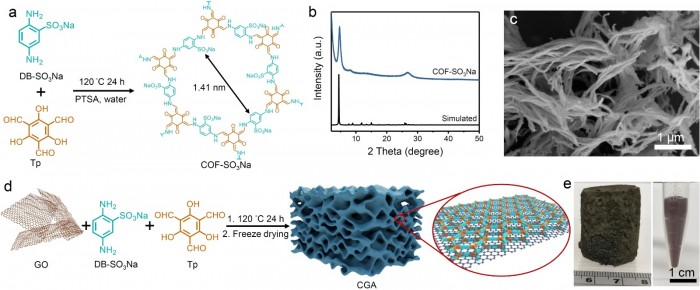Engineers at the University of Vienna have developed a new composite material that can effectively filter out organic pollutants from water. The system uses ultra-porous "nanosponges" embedded in graphene sheets.
![%NA]LDYPGIXAZ5KP4L0UI8S.png](http://6.eewimg.cn/news/uploadfile/2022/0805/20220805042709304.png)
The key to the new filter is a class of materials called covalent organic frameworks (COFs). These structures are extremely porous, giving them a huge surface area in a small space, which means they can efficiently grab a large number of molecules. Related materials called metal-organic frameworks (MOFs) are being studied for use in carbon capture, desalination or extracting drinking water from thin air, and COFs could have a similar range of functions.
In the new effort, the researchers focused on using COFs to remove organic dyes from water. These chemicals are common contaminants of industrial wastewater and can be toxic and carcinogenic—not to mention difficult to remove.

The team tuned the COFs so that they selectively grab onto organic dye molecules. This involved making the shape and size of the pores just right — between 0.8 and 1.6 nanometers — and making their surfaces negatively charged to attract the positively charged dye molecules.
But there was still a hurdle to overcome. When the material is used in powdered form, the pores at the outer edges are filled with molecules first, leaving the pores in the middle empty and essentially useless. So the team developed a way to disperse COFs by growing them on graphene sheets.
The end result is a two-nanometer-thick layer of COFs on top of a single-atom layer of graphene, which increases the material's maximum capacity to hold organic dye molecules. Graphene itself has fairly large pores, allowing water to flow quickly through while the COFs do their work.
"Thus, the macropores of the graphene network in combination with the ultrathin COFs layer and its high number of adsorption sites enable particularly fast and efficient wastewater treatment," the researchers said.
The team says the technique should also be fairly cheap. Not much graphene needs to be used, and the COFs can be cleaned out and reused.
The research was published in the journal Angewandte Chemie.
Previous article:Advantech's Luo Huancheng: Under the dual carbon era, it is time for corporate ESG governance
Next article:City carbon neutrality goal: Advantech energy-saving technology supports smart parking meter solutions
- Molex leverages SAP solutions to drive smart supply chain collaboration
- Pickering Launches New Future-Proof PXIe Single-Slot Controller for High-Performance Test and Measurement Applications
- CGD and Qorvo to jointly revolutionize motor control solutions
- Advanced gameplay, Harting takes your PCB board connection to a new level!
- Nidec Intelligent Motion is the first to launch an electric clutch ECU for two-wheeled vehicles
- Bosch and Tsinghua University renew cooperation agreement on artificial intelligence research to jointly promote the development of artificial intelligence in the industrial field
- GigaDevice unveils new MCU products, deeply unlocking industrial application scenarios with diversified products and solutions
- Advantech: Investing in Edge AI Innovation to Drive an Intelligent Future
- CGD and QORVO will revolutionize motor control solutions
- Innolux's intelligent steer-by-wire solution makes cars smarter and safer
- 8051 MCU - Parity Check
- How to efficiently balance the sensitivity of tactile sensing interfaces
- What should I do if the servo motor shakes? What causes the servo motor to shake quickly?
- 【Brushless Motor】Analysis of three-phase BLDC motor and sharing of two popular development boards
- Midea Industrial Technology's subsidiaries Clou Electronics and Hekang New Energy jointly appeared at the Munich Battery Energy Storage Exhibition and Solar Energy Exhibition
- Guoxin Sichen | Application of ferroelectric memory PB85RS2MC in power battery management, with a capacity of 2M
- Analysis of common faults of frequency converter
- In a head-on competition with Qualcomm, what kind of cockpit products has Intel come up with?
- Dalian Rongke's all-vanadium liquid flow battery energy storage equipment industrialization project has entered the sprint stage before production
- Allegro MicroSystems Introduces Advanced Magnetic and Inductive Position Sensing Solutions at Electronica 2024
- Car key in the left hand, liveness detection radar in the right hand, UWB is imperative for cars!
- After a decade of rapid development, domestic CIS has entered the market
- Aegis Dagger Battery + Thor EM-i Super Hybrid, Geely New Energy has thrown out two "king bombs"
- A brief discussion on functional safety - fault, error, and failure
- In the smart car 2.0 cycle, these core industry chains are facing major opportunities!
- The United States and Japan are developing new batteries. CATL faces challenges? How should China's new energy battery industry respond?
- Murata launches high-precision 6-axis inertial sensor for automobiles
- Ford patents pre-charge alarm to help save costs and respond to emergencies
- New real-time microcontroller system from Texas Instruments enables smarter processing in automotive and industrial applications
- Controlling LED brightness under ZSTACK
- [Analog Electronics Course Selection Test] + Input and Output Limitation
- 【LAUNCHXL-CC2650】Tool or software download and installation and SDK directory introduction
- Core Experience | Free evaluation and trial of Lingdong MM32 eminiboard, waiting for you!
- The most efficient solution for receiving and sending indefinite length packets on DSP serial port SCI
- (There are still many prizes left in the prize pool!) Mentor downloads the white paper and answers questions for a prize draw
- Be sure to pay attention to safety when driving on the road! Stay away from large vehicles!
- LCD screen display effect is related to viewing angle and contrast
- Flip switch based on LIS2DW12 of PSOC6;
- Discussion about MicroPython Engineer's Pocket Toolbox

 Growth of single-crystalline graphene on germanium substrate
Growth of single-crystalline graphene on germanium substrate











 京公网安备 11010802033920号
京公网安备 11010802033920号